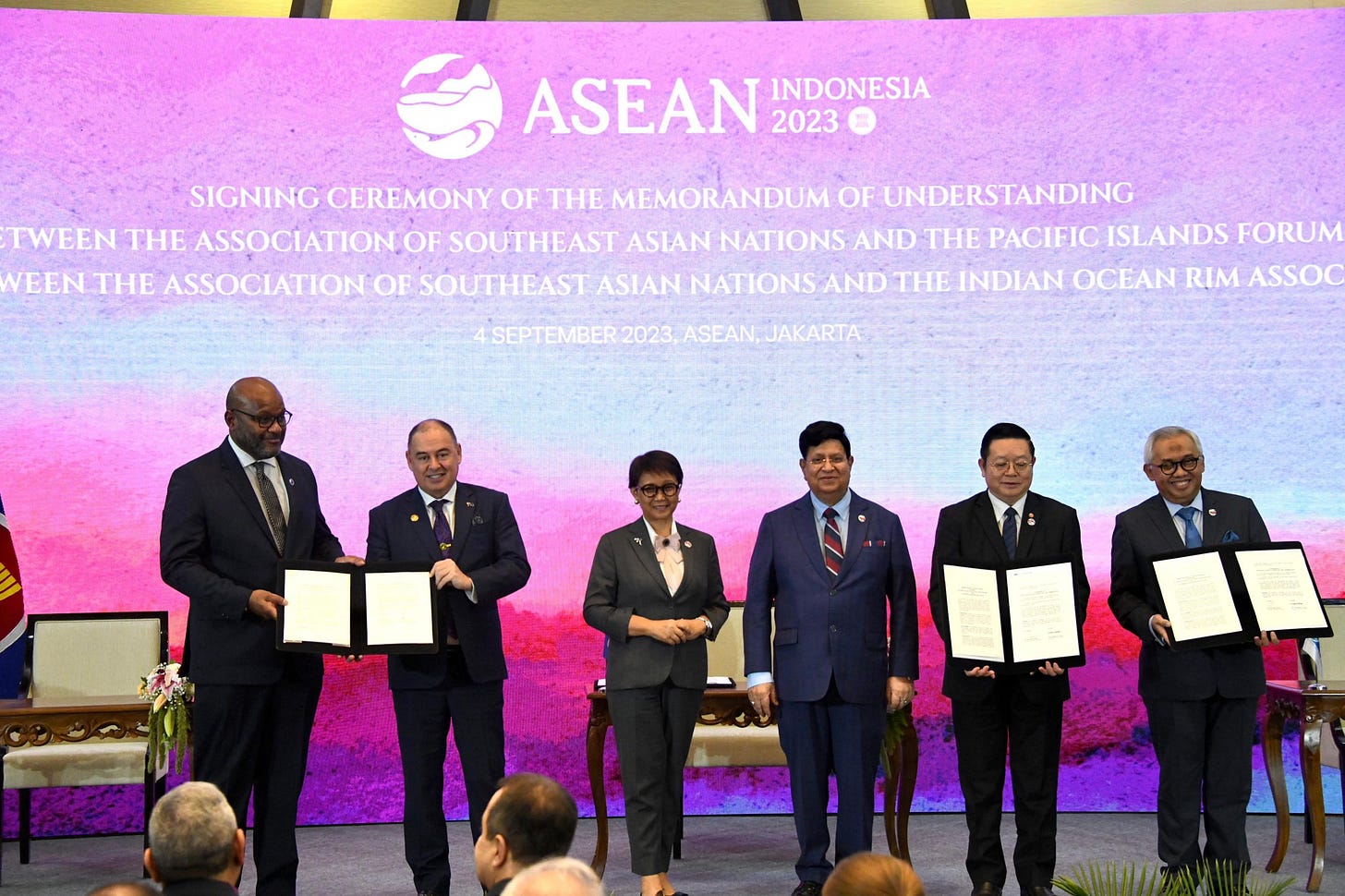ASEAN Pacific Island Links in Focus Amid Indo-Pacific Realities
Plus coming Shangri-La Dialogue; global critical minerals competition outlook; new China digital facility launch; emerging nuclear regional hub and much more.
Greetings to new readers and welcome all to the latest edition of the weekly ASEAN Wonk BulletBrief! If you haven’t already, you can upgrade to a paid subscription for $5 a month/$50 a year below to receive full posts by inserting your email address and then selecting an annual or monthly option. You can visit this page for more on pricing for institutions, groups as well as discounts. For current paid subscribers, please make sure you’re hitting the “view entire message” prompt if it comes up at the end of a post to see the full version.
For this iteration of ASEAN Wonk BulletBrief, we are looking at:
Assessing the geopolitical and geoeconomic significance of ongoing ASEAN-Pacific Island engagement amid the proliferation of Indo-Pacific strategies and in the wake of a recent notable development;
Mapping of regional developments, such as coming Shangri-La Dialogue engagements and new Indo-Pacific forum geoeconomic inroads;
Charting evolving geopolitical, geoeconomic and security trends such as the global mineral competition outlook; growing Gaza geoeconomic contagion and a new China digital facility launch;
Tracking and analysis of industry developments and quantitative indicators including an emerging nuclear regional hub; new trade deal talks kickoff and an ominous cyber warning;
And much more! ICYMI, check out our review of a new book by ex-senior officials which charts out a fresh strategy for U.S. regional commitment to Southeast Asia and the wider Indo-Pacific region.
This Week’s WonkCount: 1,967 words (~ 9 minutes)
Coming Shangri-La Dialogue Engagements; New Indo-Pacific Forum Inroads & More

Global Minerals Competition Outlook; New Regional Geopolitical Vision & Major Power Engagement Calibration
“The concentration in the mining sector looks different if viewed through the lens of asset ownership, with US and European companies playing a major role for copper and lithium supplies whereas Chinese companies have a greater role for nickel and cobalt production, despite these minerals being mined elsewhere (e.g. Indonesia for nickel and the Democratic Republic of Congo for cobalt),” notes the second iteration of the International Energy Agency’s new global critical minerals outlook (link).
Geographical Distribution of the Global Electric Vehicle Battery Supply Chain, 2023
“To understand ASEAN's response to the looming [US-China] rivalry, it is essential to examine the soon-to-be-unveiled Asean Vision 2045,” notes a commentary over at The Bangkok Post on an evolving vision set to be finalized under Malaysia’s ASEAN chairmanship in 2025. The piece notes that the current draft reflects a greater focus on the grouping’s external relations “than ever before” as well as the strengthening of key ASEAN institutions (link).
“The task for Japan in 2024-25 is to articulate a vision for a new regional architecture in East Asia and the Indo-Pacific, leveraging its unique position to reassure ASEAN and strengthen ties with Southeast Asia,” notes the latest Japan-Southeast Asia edition of Comparative Connections published by Pacific Forum. The article notes that Japan’s challenge is balancing its reaffirmation of commitment to Southeast Asia and ASEAN and creating new institutional frameworks with individual countries such as the Philippines which are perceived by some to undermine ASEAN centrality (link).
ASEAN Pacific Island Links in Focus Amid Indo-Pacific Realities
What’s Behind It
Singapore convened a new iteration of the Singapore-Pacific High-Level Visit in one of the earliest foreign policy interactions since its leadership succession. The engagement, held from May 20-22, featured visiting ministers from Pacific Island countries as well as the secretary-general of the Pacific Islands Forum (PIF) regional grouping1. It came just months after key inroads between ASEAN and Pacific Island countries as well as Singapore’s launching of its own new multi-pillared Pacific Islands package following its official admission as the latest Southeast Asian dialogue partner of the PIF joining other ASEAN members Indonesia, Malaysia, the Philippines as well as Thailand2.
Select Key Recent Engagements of Southeast Asian States and Pacific Island Countries
The engagement represented just the latest in a series of developments between Southeast Asia and Pacific Island countries (see snapshot graphic above). While links between Southeast Asia and the Pacific are far from new — for instance, as noted previously on ASEAN Wonk, Australia and New Zealand are intensifying long-held regional roles — ties between Southeast Asian states and other Pacific Island countries have been more historically limited and uneven. Recent developments have illustrated efforts to boost ties amid the proliferation of Indo-Pacific strategies. Last year, ASEAN and PIF inked a new pact to advance cooperation3. This was a key priority for Indonesia as it sought to advance the ASEAN Outlook on the Indo-Pacific (AOIP) during its chairmanship. Individual countries such as the Philippines and Thailand have also continued to explore ways to increase support for Pacific Island states via PIF and other pathways4.
Why It Matters
Initiatives like the one we saw from Singapore spotlight the extent to which Southeast Asian states are truly building out the “Pacific” aspect of their “Indo-Pacific” outlooks. Despite initiatives like the AOIP and the new ASEAN-PIF pact, officials privately concede that this is a work in progress and highly uneven amid other priorities, including expanding engagement by some member states in other subregions like the Indian Ocean and preoccupation with internal issues like the South China Sea and Myanmar. For instance, even though Singapore’s admission as a PIF dialogue partner in 2021 meant all of the five original ASEAN founding members in 1967 had this status optics-wise, Thailand is the lone mainland Southeast Asia country, illustrating the mainland-maritime gap on this score which has also persisted across some other issues as well5.
These engagement efforts also highlight the extent of convergence in cooperation areas between Southeast Asia and other regions such as the Pacific Islands (see table below, along with more on future prospects in the “Where It’s Headed” section. Paid subscribers can read on thereafter to the remaining sections of our weekly ASEAN Wonk BulletBrief).











